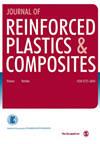多壁碳纳米管/编织玻璃/环氧混合纳米复合材料:制造方法和环氧基质类型的影响
IF 2.2
3区 材料科学
Q3 MATERIALS SCIENCE, COMPOSITES
引用次数: 0
摘要
将纳米填料杂化到玻璃纤维增强材料中是一种很有前途的改善复合材料性能的策略。本研究旨在探讨由多壁式碳纳米管(MWCNT)/玻璃纤维编织物/环氧树脂复合材料组成的混合纳米复合材料的性能。同时还研究了不同制造方法和不同类型环氧树脂基材的影响。在方法 1 中,MWCNT 与环氧树脂混合,并通过手糊法浸渍到 3 层玻璃编织物中,然后进行真空装袋。同时,在方法 2 中,用 MWCNT 水悬浮液喷涂玻璃编织物,并将 3 层玻璃编织物堆叠在一起,用手糊法浸渍环氧树脂,然后进行真空装袋。结果表明,与方法 1 相比,采用方法 2 制备的含有 0.5 wt% MWCNT 的复合材料层压板的冲击强度和弯曲强度分别提高了 32.9% 和 29%。根据可燃性测试观察到,两种方法制备的混合层压复合材料都可以自熄。研究发现,使用双酚 A 作为环氧基质的混合层压复合材料与环氧生物树脂相比,冲击强度和弯曲强度分别提高了 20.7% 和 12%。本文章由计算机程序翻译,如有差异,请以英文原文为准。
Multi-walled carbon nanotubes/woven glass/epoxy hybrid nanocomposites: Effect of fabrication methods and types of epoxy matrices
The hybridization of nanofillers into glass fibre reinforcement is a promising strategy to improve the properties of the composite materials. The study aims to investigate the properties of hybrid nanocomposites consisting of multi-walled carbon nanotube (MWCNT)/woven glass/epoxy composites. The effect of different fabrication methods and different types of epoxy matrices was also investigated. For method 1, MWCNT was mixed with epoxy and impregnated into 3-ply woven glass fabrics using the hand lay-up method, followed by a vacuum bagging process. Meanwhile, for method 2, the woven glass fabrics were spray coated with MWCNT aqueous suspension and 3-ply woven glass fabrics were stacked together and impregnated with epoxy using the hand lay-up method followed by vacuum bagging. Results showed that composite laminates prepared by method 2 with 0.5 wt% MWCNT exhibit higher impact and flexural strength with 32.9% and 29% increments compared to method 1, respectively. Based on the flammability test, it was observed that hybrid laminate composites fabricated by both methods could self-extinguish. It was found that hybrid laminated composites using bisphenol A as an epoxy matrix show higher impact strength and flexural strength with 20.7% and 12% increments compared to epoxy bio-resins, respectively.
求助全文
通过发布文献求助,成功后即可免费获取论文全文。
去求助
来源期刊

Journal of Reinforced Plastics and Composites
工程技术-材料科学:复合
CiteScore
5.40
自引率
6.50%
发文量
82
审稿时长
1.3 months
期刊介绍:
The Journal of Reinforced Plastics and Composites is a fully peer-reviewed international journal that publishes original research and review articles on a broad range of today''s reinforced plastics and composites including areas in:
Constituent materials: matrix materials, reinforcements and coatings.
Properties and performance: The results of testing, predictive models, and in-service evaluation of a wide range of materials are published, providing the reader with extensive properties data for reference.
Analysis and design: Frequency reports on these subjects inform the reader of analytical techniques, design processes and the many design options available in materials composition.
Processing and fabrication: There is increased interest among materials engineers in cost-effective processing.
Applications: Reports on new materials R&D are often related to the service requirements of specific application areas, such as automotive, marine, construction and aviation.
Reports on special topics are regularly included such as recycling, environmental effects, novel materials, computer-aided design, predictive modelling, and "smart" composite materials.
"The articles in the Journal of Reinforced Plastics and Products are must reading for engineers in industry and for researchers working on leading edge problems" Professor Emeritus Stephen W Tsai National Sun Yat-sen University, Taiwan
This journal is a member of the Committee on Publication Ethics (COPE).
 求助内容:
求助内容: 应助结果提醒方式:
应助结果提醒方式:


